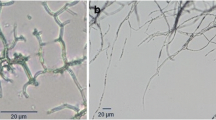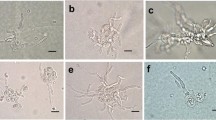Summary
Xanthoria parietina is a lichen constituted by an Ascomycete as the fungal partner and by Trebouxia and Pseudotrebouxia as green algal phyco-or photobionts. Cellular cycle and development of the photobionts seem to be regulated by the mycobiont, although the molecular bases of these phenomena are still unknown. The phycocide characteristic of lichen phenolics as well as the capacity to enter the algae let us think that these compounds may be related to the control of photobiont growth and development. Besides, fungal isolectins with arginase activity are implicated in the complex mechanism of regulation between the mycobiont and the phycobiont. This work compares the distribution of frequencies of the cellular size of recent-isolated photobionts and cultured photobionts under aposymbiotic conditions during two months. The observed high yield of aplano-sporangia in culture, in contrast to the results obtained under natural conditions, is an evidence for strict control of the mycobiont upon the phycobiont.
Access this chapter
Tax calculation will be finalised at checkout
Purchases are for personal use only
Preview
Unable to display preview. Download preview PDF.
Similar content being viewed by others
References
Ahmadjian V (1973). In: Ahmadjian V, Hale ME (eds) The lichens. New York, Academic Press, pp 565–579
Ahmadjian V (1982). In: Round FJ, Chapman DJ (eds) Progress in Phycological Research, Elsevier Biomedial Press, Amsterdam, pp 179–233
Ahmadjian V Brink JJ, Shehaata A I (1991). In: Molecular biology of lichens. Search for plasmid DNA and the question of gene movement between bionts. Proc Intern Symp Liehenol, Nippon Paint Co, Osaka, pp 2–21
Ascaso C (1980). Ann Bot 45: 483
Avalos A, Vicente C (1987). Plant Cell Reports 6: 74–76
Bubrick P, Galun M (1986). Lichenologist 18: 47–49
Deason DR, Bold HC (1960). Univ Texas Publ 6022: 1–70
Hill DJ (1985). In: Brown DH (ed) Liehen Physiology and Cell Biology. Plenum Press, London, pp 303–317
Holopainen T, Kauppi M (1989). Lichenologist 21: 119–134
Honegger R (1987). Bibl Lichenol 25: 59–71 Honegger R (1991). Ann Rev Physiol Plant Mol Biol 42: 553–578
Honegger R (1991). Ann Rev Physiol Plant Mol Biol 42: 553–578
Molina MC, Vicente C (1993). In: Sato S, Ishida M, Ishikawa H (eds) ENDOCYTO-BIOLOGY V, Tübingen University Press, Tübingen, pp 69–74
Molina MC, Vicente C (1995). Cell Adh Com 3: 1–12
Molina MC, Muñiz E, Vicente C (1993). Plant Physiol Biochem 31: 131–142
Molina MC, Vicente C, Muñiz, E (1994). Acta Horticulturae 381: 417–420
Pedrosa MC, Legaz E (1991). Symbiosis 11: 345–357
Slocum RD, Ahmadjian V, Hildredth KC (1980). Lichenologist 12: 173–187
Stocker-Wörgötter E, Türk R (1989). Nova Hedwigia 48: 207: 228
Stocker-Wörgötter E, Türk R (1993). Crypt Bot 3: 283–289
Author information
Authors and Affiliations
Editor information
Editors and Affiliations
Rights and permissions
Copyright information
© 1997 Springer-Verlag Berlin Heidelberg
About this paper
Cite this paper
Molina, M.C., Stocker-Wörgötter, E., Zorer, R., Türk, R., Vicente, C. (1997). Comparison Between Recent-Isolated and Cultured Populations of Phycobionts From Xanthoria parietina (L.). In: Schenk, H.E.A., Herrmann, R.G., Jeon, K.W., Müller, N.E., Schwemmler, W. (eds) Eukaryotism and Symbiosis. Springer, Berlin, Heidelberg. https://doi.org/10.1007/978-3-642-60885-8_42
Download citation
DOI: https://doi.org/10.1007/978-3-642-60885-8_42
Publisher Name: Springer, Berlin, Heidelberg
Print ISBN: 978-3-642-64598-3
Online ISBN: 978-3-642-60885-8
eBook Packages: Springer Book Archive




